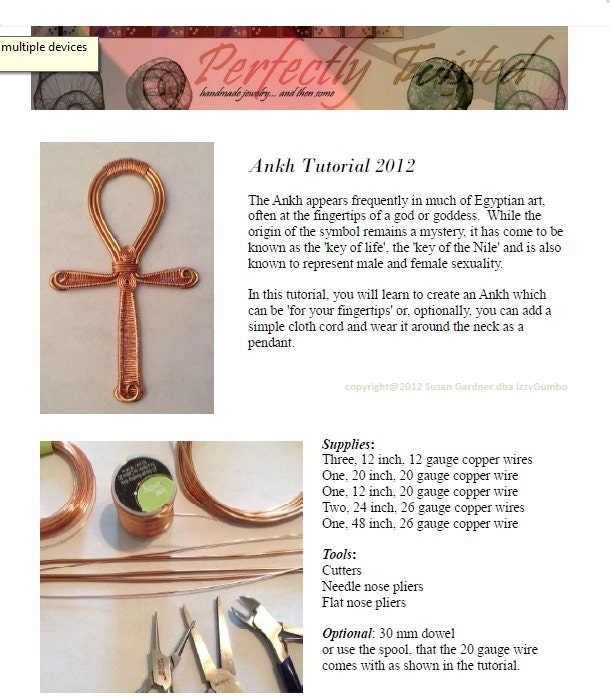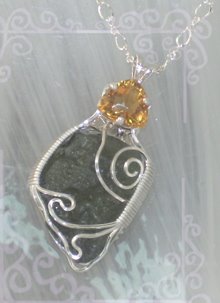This can be one of the most unique and beautiful wire techniques, however it can also be the most frustrating and tedious to learn... there is no getting around the fact that it takes practice and a whole lot of patience. I've been working on learning it for a few months now and learning how to keep the wire neat, tight and attractive... many sighs and in one case, tears, later, I think I'm finally starting to understand what it takes.
I want to share what I learn with you to help get you over the very frustrating starting points. It looks a lot easier than it is and so I give huge credit to those artists who seem to do magic with these techniques, they truly have learned and applied a worthy skill of wire craft. There certainly are many others who have opinion on how 'best' to do these techniques so I encourage you to explore and read as the things I'm covering with you are from my own personal experience, there may be better ways... please share via comment if you'd like as I'm also, still learning.
Beginning Tips:
1. Use a small gauge wire to do the weaving, 26g and 28g is what I use. Use a larger, more sturdy wire for the frame of your piece.
2. Use a manageable length, I use 3 to 5 feet at a time. I don't hold my wire coiled up like I've read in other places. I use the wire length loose, like a thread. Weaving with more than 3 to 5 feet at a time becomes difficult to manage and the wire hardens as you weave, so a longer length, I've found, causes kinking and breaking along with just being hard to handle. Working with one foot of wire at a time, will get you no where fast... a foot of 26g wire, weaved around 16g seems to create approximately 1/2 inch of weaved work. Three feet of 26g wire seems to create just over an inch to 1.5 inch at a time of weaved work, depending on the size of the frame wires and the pattern of your weave.
3. If you work with your weaving wire loose like I do, be careful of your eyes, the wire can still be a bit difficult to handle when you are first beginning and I've come close to poking myself in the face. Either use eye wear or just always be mindful of that loose end.
4. Keep the weaving wire working in the direction of it's natural bend (as it came off the spool). Normally I take a 3 foot length of wire and gently 'straighten it' by pressing it between my fingers. Coming off the spool, it has a natural loose coil already on it and I find this hard to work with, so I take the moment to press it into a straight piece of wire.
5. Keep a controlled but slight tension on the weaving wire as you work. Push it snug to the frame wire and use your flat nose pliers when the wire becomes short and hard to push or pull tight. Don't continually 'rub' your wire straight as this will cause hardening, making it brittle.
6. Work slowly and neatly, ensuring that the weaved loop does not overlap the previous one... this is the hard to do part, but keeping patient and making sure each wrap is snug and flat against the frame wire will make for a better and more beautiful piece when done.
This will be effort anyway, so make it worth it. There is no 'fast way' to do this technique, so prepare yourself, before you begin and make sure you work in good lighting.
7. Pay attention to your weave, what direction you are working in and what count of loop you're on... this will matter because eventually, you will 'end' one length of wire and have to 'begin' a new length of wire to get through the distance of your frame. Learning to keep focus will keep your weave uniform.
8. When working with a frame that has angles or joins, it is best to start your weave at the most narrow point of the frame and work into the wider spaces.
I hope this helps for now and I hope you continue to return and read as I intend to post a few more articles about wire weaving and how to learn this beautiful technique. I will also be showing a few different weaving patterns and some simple projects that you can try.
.JPG)
.JPG)

.JPG)
.JPG)
-001.JPG)

.JPG)
.JPG)
.JPG)
-001.JPG)
.JPG)
-001.JPG)
.JPG)
.JPG)
.JPG)
-002.JPG)
.JPG)
-001.JPG)
.JPG)
.JPG)
.JPG)
-001.JPG)
-001.JPG)
.JPG)
.JPG)

.JPG)








-001.JPG)
.JPG)
-002.JPG)
-001.JPG)
.JPG)
-001.JPG)


.JPG)



.JPG)







.JPG)
-002.JPG)











